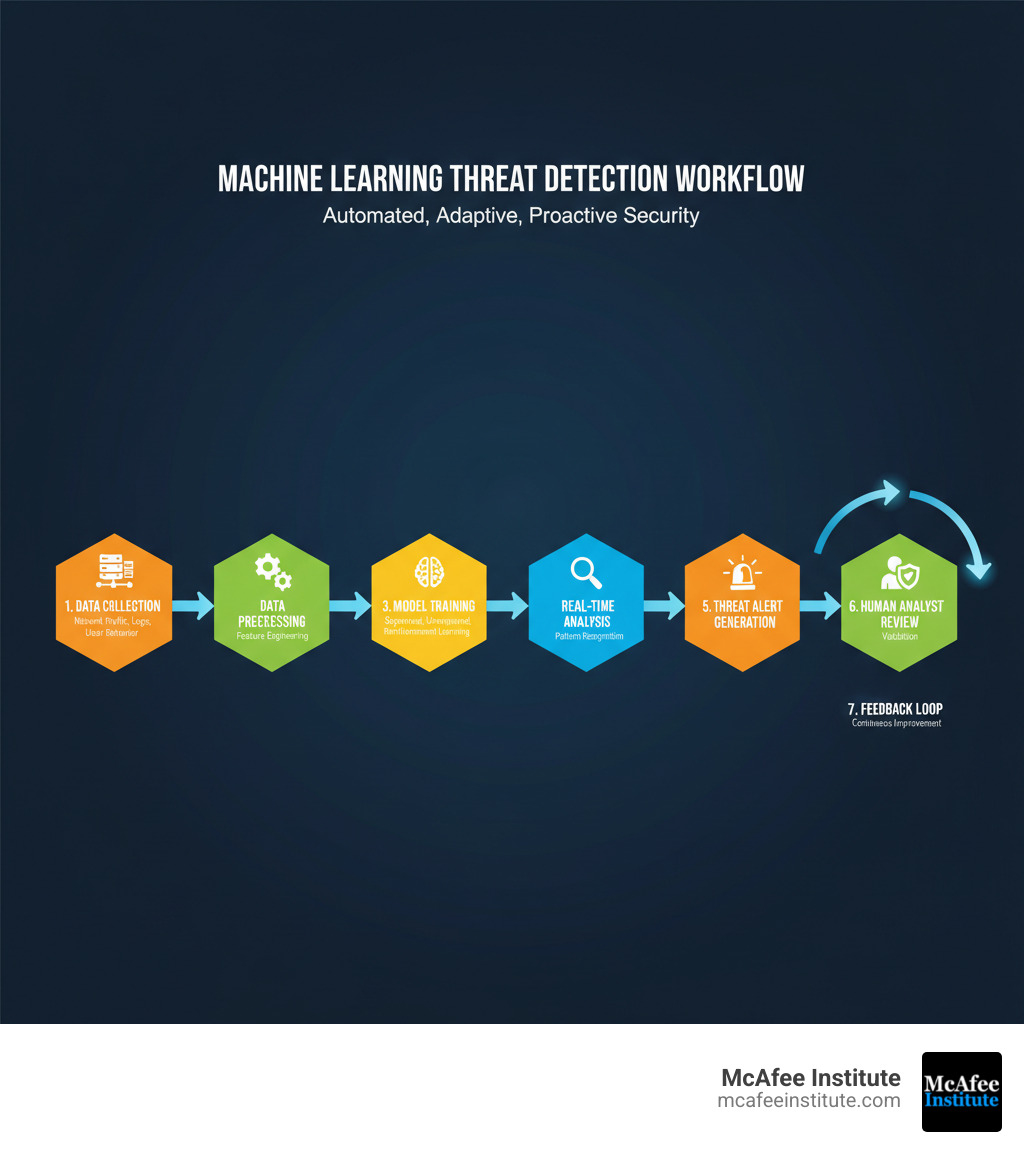Why Machine Learning for Threat Detection Matters Now More Than Ever
Machine learning for threat detection is changing how investigators and intelligence professionals identify, analyze, and respond to digital threats in real time. Unlike traditional systems that rely on static rules and known signatures, machine learning continuously learns from vast datasets. It excels at automated pattern recognition, analyzing millions of data points to spot suspicious activity at machine speed. This allows for a proactive defense that detects previously unknown threats through anomaly detection, not just signatures.
At its core, ML offers adaptive learning, where models improve by studying new threats and analyst feedback, which reduces false positives and alert fatigue. The threat landscape has evolved dramatically, with adversaries deploying sophisticated, AI-improved attacks. The sheer volume of threat data is impossible for human analysts to process manually, creating both a challenge and an opportunity for investigators and law enforcement.
The opportunity lies in leveraging machine learning to augment human expertise. ML automates repetitive analysis, allowing investigators to focus on high-value threats. It doesn't replace human judgment—it amplifies it. While algorithms process data, experienced investigators provide the context, strategic thinking, and ethical oversight that machines cannot. This human-machine partnership is the future of threat intelligence.
I'm Joshua McAfee, and I've spent my career building systems that protect people and organizations from evolving threats. From developing Amazon's Loss Prevention program to training thousands of professionals worldwide through McAfee Institute, I've seen how machine learning for threat detection empowers investigators to work smarter, faster, and more effectively against sophisticated adversaries.

How Machine Learning Empowers Threat Investigators
Machine learning for threat detection doesn't replace investigators—it gives them superpowers. It acts as a tireless assistant, processing millions of alerts to flag what's truly suspicious, letting you focus on making judgment calls and connecting the dots.
AI vs. ML: A Quick Distinction
People often use Artificial Intelligence (AI) and Machine Learning (ML) interchangeably, but they aren't the same. AI is the broad concept of making computers act intelligently. ML is a specific subset of AI that teaches computers to learn from data without being explicitly programmed for every scenario. For threat detection, ML provides the practical techniques that allow a system to spot a phishing campaign or flag unusual network behavior by learning what "normal" and "suspicious" look like. As AI transforms the future of investigations, it's ML that makes this change possible.
The Core Process: How ML Works in Threat Detection
Modern investigators face an overwhelming volume of data from network traffic, system logs, and user activities. Machine learning for threat detection processes these millions of data points at machine speed. The process begins with data collection from numerous sources, followed by preprocessing to clean and organize the raw data. Next is feature extraction, where investigators help identify the most telling data points, such as "failed login attempts from unusual locations." This prepared data is used for model training, where an algorithm learns to distinguish between normal and malicious activity by studying historical examples. Once trained, the model performs real-time analysis on live data, flagging potential threats. The most crucial element is the feedback loop: when an investigator confirms or dismisses an alert, that feedback is used to retrain the model, making it smarter and more accurate over time. This adaptive approach is key to modern defense strategies, as detailed in this comprehensive review of cybersecurity strategies.
Understanding the Types of Machine Learning
Different ML types are suited for different challenges.
Supervised Learning
Supervised learning uses labeled data—information already tagged as "malicious" or "benign." The model studies these examples to learn the characteristics of dangerous activity. This is highly effective for detecting known threats, like training a model to recognize phishing emails by showing it thousands of examples.
Unsupervised Learning
Unsupervised learning works with unlabeled data, exploring it to find patterns and anomalies. This is a secret weapon against unknown threats and zero-day attacks. The model establishes a baseline of "normal" behavior for your environment and flags significant deviations, such as a user suddenly downloading 10,000 files when they normally access 10. It doesn't need to have seen the threat before; it just knows something is out of place.
Reinforcement Learning
Reinforcement learning learns through trial and error. The system performs actions and receives feedback (rewards or penalties), adjusting its strategy to optimize responses. This can create adaptive systems that learn which IP addresses to block or which alerts to escalate, becoming more sophisticated with each decision.
The ML-Based Investigation Workflow
Integrating ML boosts your investigative process. It starts with automated evidence gathering at a massive scale. The ML system then performs feature extraction, identifying the signals that matter. These features feed into deployed models for real-time analysis. The critical feedback loop ensures continuous improvement, as models learn from your team's expertise. This virtuous cycle reduces noise and allows human investigators to focus their limited time on high-value analysis, creating a perfect partnership between human judgment and machine processing power.
Core Applications of Machine Learning for Threat Detection
Now that we understand the theory, let's look at where machine learning for threat detection shines in the real world. These applications move investigators from reactive work to proactive defense, allowing them to spot threats as they emerge.
Uncovering Malware and Malicious Tools
Traditional malware detection relies on signatures of known threats, which is ineffective against new attacks. Machine learning flips this script by learning what malicious behavior looks like. It examines file attributes and, more importantly, how files behave after execution. Does a program try to modify system files or make unusual network connections? This behavioral analysis is powerful against zero-day threats that have no existing signature.
ML models can even detect malware in encrypted traffic without decrypting it by analyzing metadata and traffic flow patterns—the digital equivalent of spotting a suspicious conversation by observing body language. Beyond individual files, ML helps identify entire criminal toolkits and attack infrastructures by analyzing internet activity, allowing investigators to disrupt operations at scale.
Detecting Phishing, Spam, and Social Engineering
Phishing exploits human psychology, making it a persistent threat. Natural Language Processing (NLP), a type of ML, is invaluable here. NLP models analyze the content, context, and tone of emails to understand malicious intent, not just keywords. They examine email metadata and sender patterns to spot subtle inconsistencies that humans miss, such as a slightly misspelled domain or unusual language. By analyzing communication patterns across massive datasets, ML can connect the dots to reveal large-scale fraud campaigns. For investigators using Open Source Intelligence (OSINT), NLP also helps automatically extract threat indicators from public sources, accelerating response times.
Identifying Insider Threats and Anomalous Behavior
Insider threats are tricky because the activity often appears legitimate. User Behavior Analytics (UBA), powered by machine learning, is essential for detection. UBA systems build a behavioral baseline for each user—typical login times, resources accessed, data transfer volumes—and then watch for significant deviations. These anomalies, which warrant investigation, can include an employee suddenly accessing sensitive databases at 3 AM or downloading unusual file types.
This access pattern analysis is also critical for detecting compromised accounts. One of the most important applications is spotting data exfiltration. ML can identify attempts to transfer unusually large amounts of data to external storage or personal accounts. Common indicators ML helps identify include unusual login times or locations, accessing data outside of normal job functions, and sudden large data transfers. These patterns, often emerging gradually, are flagged by ML systems for human experts to investigate further.
Implementing ML in Your Investigative Strategy: Benefits & Challenges

Integrating machine learning for threat detection into your investigative work is a strategic shift with both opportunities and challenges. For investigators who understand both, ML becomes a powerful force multiplier.
Key Benefits for Intelligence and Law Enforcement
The primary benefits are transformative. ML provides automation at scale, handling the tedious analysis of massive datasets and freeing up investigators for strategic thinking. It delivers increased speed and accuracy, processing millions of data points in milliseconds to spot threats in near real-time. A key advantage is the reduction of false positives; as models learn your environment's normal patterns, they become better at distinguishing real threats from benign anomalies, reducing alert fatigue. Most importantly, ML enables proactive threat hunting by identifying subtle patterns and predicting potential attacks, including zero-day threats that traditional systems miss. It fundamentally improves analytical capabilities, augmenting human expertise with machine-powered pattern recognition.
Challenges and Risks to Consider
Adopting ML is not without its problems. The foundation of any ML system is data, and poor data quality and diversity will lead to a flawed model. Another growing concern is adversarial attacks, where attackers deliberately manipulate data to evade detection. This requires continuous model retraining and robust defenses against evasion techniques, as detailed in research on adversarial attacks in machine learning.
Technical challenges like model overfitting—where a model memorizes training data instead of learning general patterns—can cause it to fail in real-world scenarios. Furthermore, a talent shortage of professionals who bridge both data science and investigative work makes implementation difficult. Finally, ethical considerations around data privacy and potential misuse require careful oversight and compliance.
The Role of Explainable AI (XAI) in Building Cases
Many ML models can feel like black boxes, which is a problem when you need to build a case or testify in court. Explainable AI (XAI) is the solution. XAI makes ML models transparent, showing exactly how a conclusion was reached.
This model transparency is essential for justifying alerts and building defensible cases. Instead of just saying an email was flagged, XAI can show it was due to a suspicious sender, unusual links, and specific language patterns. This builds trust among your team and ensures they use the tools effectively. For law enforcement, XAI addresses evidentiary standards, providing the reasoning and verifiable evidence required in legal proceedings. It turns a black box into a trustworthy and defensible investigative tool.
The Future of AI-Driven Threat Intelligence

The threat landscape isn't standing still, and neither can we. The future of threat intelligence lies in combining human expertise with machine intelligence to become smarter and faster than our adversaries.
Combining ML with Traditional Investigative Techniques
Machine learning for threat detection doesn't replace good detective work; it boosts it. The most effective teams use a hybrid approach, blending ML's pattern-recognition power with the critical thinking and intuition of experienced investigators. This human-in-the-loop model uses machines for the heavy data analysis while humans provide the final judgment calls.
ML is also a game-changer for augmenting OSINT, processing millions of public data points in minutes to identify intelligence on threat actors and campaigns. There are many high-value OSINT techniques with AI that are expanding these possibilities. In digital forensics integration, ML can rapidly analyze compromised systems to find artifacts of malicious activity, but it's the human expert who interprets the findings and builds a narrative that holds up in court.
Preparing for AI-Powered Adversaries
While we use AI to strengthen defenses, criminals are weaponizing it for attacks, creating an AI arms race. One of the most troubling developments is AI-generated misinformation and deepfakes. Generative AI can create realistic synthetic audio and video to authorize fraudulent transfers or even frame innocent people. The good news is that ML is also evolving to counter these threats by analyzing micro-expressions, lighting, and other telltale signs of digital manipulation.
Adversaries are also using AI to launch automated attacks with polymorphic malware that constantly changes to evade detection. To stay ahead of the curve, our ML models must be constantly retrained with new threat data. We must also accept emerging technologies like federated learning, which allows for collaborative model training without sharing sensitive data. Pushing for Explainable AI (XAI) as a standard is also crucial for legal and ethical accountability. The investigators who thrive will be those who combine cutting-edge technology with experienced human judgment.
Frequently Asked Questions about Machine Learning in Threat Detection
How does machine learning for threat detection differ from traditional rule-based systems?
Traditional systems are like a security guard with a list of known suspects; they rely on predefined rules and signatures to find exact matches of known threats. They struggle with new or disguised attacks.
Machine learning for threat detection is different. It learns from vast datasets to recognize patterns of behavior. Instead of looking for a specific signature, it establishes a baseline of "normal" and flags anomalies. This allows it to identify novel threats, including zero-day attacks, that have never been seen before. It's adaptive, continuously learning from new data to improve accuracy and reduce the false positives that plague rule-based systems.
Can ML models operate without human supervision?
While some ML models can identify anomalies automatically, effective threat detection absolutely requires a "human-in-the-loop" approach. ML excels at processing massive volumes of data at machine speed, but it lacks human context, intuition, and strategic thinking.
An experienced investigator is needed to validate alerts, distinguishing a real threat from a benign anomaly. Humans provide contextual analysis, connecting data points to broader investigations or real-world events. They also make strategic decisions on how to respond to a confirmed threat and provide essential ethical oversight. ML is a powerful assistant that amplifies human capabilities, not a replacement for them.
What skills are needed to work with machine learning for threat detection?
Working in this field requires a unique blend of skills. You don't have to be a programmer, but you need to be a skilled investigator who understands how to leverage these new tools.
Key skills include:
- Data analysis and interpretation: Comfort working with large datasets and understanding model outputs like confidence scores.
- Foundational ML concepts: Understanding the different types of learning (supervised, unsupervised) and how they apply to investigations.
- Domain expertise: Deep knowledge of threat landscapes and investigative methodologies is critical to apply the tools effectively.
- Critical thinking and problem-solving: The ability to analyze complex situations and develop solutions, especially against novel threats.
At McAfee Institute, our certification programs are designed to equip professionals with this exact blend of technical knowledge and real-world investigative expertise, providing practical skills you can apply immediately.
Conclusion
Machine learning for threat detection has fundamentally changed investigations, shifting us from reacting to adversaries to proactively hunting them. We can now spot patterns invisible to the human eye and process intelligence at a scale once unimaginable, uncovering everything from sophisticated malware to the subtle signs of an insider threat.
But the most important takeaway is this: ML doesn't replace investigators; it makes them more effective. It frees you from tedious data sifting to focus on what only humans can do: applying context, making strategic decisions, and using real-world experience. The most powerful defense is the partnership between human judgment and machine efficiency.
As this technology evolves, so do the threats. Adversaries are weaponizing the same AI tools we use for defense. To stay ahead, specialized training is essential. You need to understand how to interpret ML findings, guide their learning, and integrate them into your investigative workflow.
At McAfee Institute, our government-recognized and employer-trusted programs are built for professionals like you. With lifetime access and support, our certifications provide the practical, actionable knowledge needed to lead in this new era of intelligence. The future of investigations is here. The question is whether you'll be leading the charge.
Ready to master the intelligence tools that are reshaping investigations?












Share:
From Wallet to Wallet: A Forensic Guide to Monitoring Crypto Transactions
Uncover Digital Clues: Essential OSINT Tools for Social Media